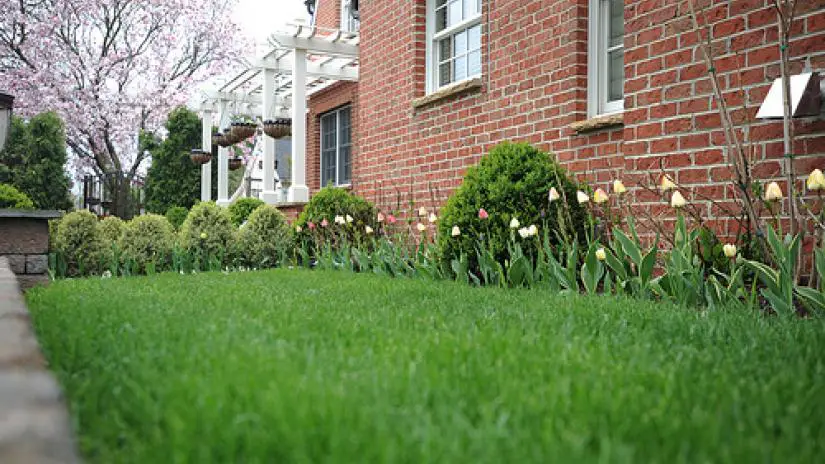
Every Spring, we say farewell to winter by deep-cleaning our homes, letting the stale air out, and welcoming in the fresh air. We do this not only to prepare for the upcoming warmer season but also to rid our homes of built-up clutter that accumulates throughout the winter. Preparing your lawn for spring is just as important. Following these simple steps in early spring will help your lawn start the year off in the right direction.
Clean-up the Landscaping
Winter's harsh weather can leave your landscaping littered with limbs and mounds of mushy rubbish. Cleaning up these winter messes will not only make your landscaping look better but will also eliminate hiding areas for unwanted insects. Matted clumps of heavy wet leaves can also prevent much need nutrients from getting to your plant's roots for proper absorption.
Clean-up the Lawn
As the snow melts away, unmaintained debris in the lawn is revealed. Whether it be clumps of late fallen leaves or pet messes that have accumulated over the winter, these can stunt the growth of grass beneath. Removing debris in the spring can help improve the lawn's appearance as it comes out of dormancy and promotes healthy growth.
Equipment Maintenance
There is nothing more frustrating than heading out to cut the lawn to find out that your mower won't start. We recommend having your lawn equipment serviced every spring prior to the start of the mowing season. No matter if you have a push mower or a riding lawn mower, proper maintenance is important to the longevity of your mower and the quality of its cut. Here is an equipment maintenance checklist for the Do-It-Yourselfer.
Treating the Lawn
A proper spring lawn care program will provide your lawn with nutrients and support that will set the stage for the lawn's overall performance for the growing season.
Apply Fertilizer
Central Indiana weather can change dramatically in the spring. It's not uncommon for us Hoosiers to have a few weeks of 50-60 degree temperatures followed by a week or two of frigid-snowy weather. As temperatures fluctuate, Indiana lawns can teeter in and out of dormancy, causing stress to our lawns. Like a bear seeking food when it comes out of hibernation, lawns are equally hungry for nutrition. A proper spring fertilization program will help alleviate stress caused by changing weather and provide the nutrients your lawn needs in the spring. The best time for feeding your lawn in Central Indiana depends on the weather. Fertilizer can be applied as early as mid-February. One thing to keep in mind when deciding when to start your spring lawn care program is not to wait too long to begin. If you fertilize your lawn in mid to late February, then get a surprise snowstorm in March; that doesn't mean you've wasted your money. Even if your lawn starts to teeter back into dormancy, your lawn's root system will store the nutrients instead of pushing the nutrients up through the grass blades, actively using it up.
Apply Pre-Emergent Herbicide
Crabgrass is a common weed that can plague Central Indiana Lawns. You don't see signs of crabgrass and most other grassy weeds until early summer. However, it is imperative to be proactive in the early spring to prevent an outbreak later on in the season. Research shows that crabgrass germinates when the soil temperatures are above 60 degrees for 3-5 days. The pre-emergent application is a protective barrier, preventing grassy weeds from breaking through the surface of the lawn. Timing is key! Once grassy weeds have emerged from the ground, a pre-emergent will no longer control these weeds. This is why Lawn Pride recommends applying a pre-emergent application in the spring (mid-February to May).
Control Weeds
With spring comes the dreaded dandelions. As kids, we enjoyed picking dandelions and making wishes as we blew away their seeds. As homeowners, they are the bane of our existence. When we see our lawns speckled with bright yellow blooms or tall stems towering over a lawn that was just mowed yesterday, we sigh with disgust. Unfortunately, it's impossible to prevent weeds from germinating. This is why it is crucial to stay on top of weeds with a consistent weed control regimen to will improve your lawn appearance and give you a lawn that you can be proud of.
When choosing a weed control regimen for your lawn, make sure to use a turf safe product. Never use a vegetation killer in the lawn, even for a "spot spray." This type of weed killer will kill not only the weed but also the grass surrounding it, leaving a softball-sized dead spot that will not recover. Professional lawn care programs will provide consistent weed control. Lawn Pride's 7-Application Program will not only give you consistent weed control but includes a free weed touch-up between applications.
Mowing Recommendations
It can be difficult maintaining a regular mowing schedule due to the increased amounts of rain that spring brings. Below are a few mowing recommendations for the spring.
Mow Tall and Often
Mow at the height of 3.5 to 4 inches. This is better for the overall health of your lawn because it promotes root growth and even aids in weed prevention. The more precipitation the lawn gets, the faster it will grow, increasing the frequency your lawn will need to be mowed. Mowing often will also help maintain the one-third rule.
Avoid Mowing Wet Grass
While it can be difficult only to mow the lawn when the grass is dry, due to the increased amounts of precipitation in the spring, try to avoid it at all costs. Here's why:
- It's Not Good for Your Lawn- water weighs down grass blades causing them not to stand up as dry grass blades do. This can cause uneven growth and an uneven cut and creates ideal conditions for fungus to spread. The lawnmower can also cause ruts and cause compact the soil.
- It's Bad for Your Mower- Moisture is never good on metal, and that includes your lawnmower. Wet grass clippings also tend to cake the underside of the mower, which causes stress to the engine, impedes the rotation of the blade, making your engine work harder than it should.
- It's Not Safe- Besides the fact that the risk of slipping while mowing is greatly increased when mowing on wet grass, you could pull a muscle. Not to mention if you fell in the path of the mower, you could lose a limb.
Don't Bag the Clippings
Grass clippings are a good source of nutrients for your lawn. As the dead grass clippings break down over time, the nutrients will release into the soil. There are two exceptions when removing lawn clippings would be recommended. The first is if your lawn is left with clumps of grass. Clumps of grass clippings left on the lawn will hinder the photosynthesis process to the grass beneath, causing uneven growth, discoloration, even bare spots. Clumping can be caused by mowing when the lawn is wet, poor mower maintenance, or if you have long periods of time between mowings. The second exception is if you have a turf disease on your lawn. Some lawn diseases will spread, so collecting the lawn clippings can help contain the spread of the disease.
